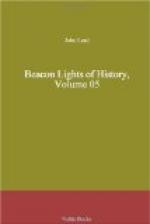more cheerful and intelligent. More calm is the
imposing facade, with its mighty towers and lofty spires,
tapering like a pyramid, with its round oriel window
rich in beautiful tracery, and its wide portal with
sculptured saints and martyrs. And in all the
churches you see geometrical proportions. “Even
the cross of the church is deduced from the figure
by which Euclid constructed the equilateral triangle,”
The columns present the proportions of the Doric,
as to diameter and height. The love of the true
and beautiful meet. The natural and supernatural
both appear. All parts symbolize the passion of
Christ. If the crypt speaks of death, the lofty
and vaulted roof and the beautiful pointed arches,
and the cheerful window, and the jubilant chants speak
of life. “The old church reminds one of
the Christ that lay in the tomb; the new, of the Christ
who arose the third day.” The old fosters
meditation and silence; the new kindles the imagination,
by its variety of perspective arrangement and mystic
representation,—still reverential, still
expressive of consecrated sentiments, yet more cheerful.
The foliated shaft, the rich tracery of the window,
the graceful pinnacle, the Arabian gorgeousness of
the interior,—as if the crusaders had learned
something from the East,—the innumerable
shrines and pictures, the variegated marbles of the
altar, with its vessels of silver and gold, the splendid
dresses of the priests, the imposing character of
the ritualism, the treasures lavished everywhere, all
speak greater independence, wealth, and power.
The church takes the place of all amusements.
Its various attractions draw together the people from
their farms and shops. They are gaily dressed,
as if they were attending a festival. Their condition
is so improved that they have time for holidays.
And these the Church multiplies; for perpetual toil
is the grave of intellect. The people must have
rest, amusement, excitement. All these things
the Catholic Church gives, and consecrates. Crusader,
baron, knight, priest, peasant, all resort to the church
for benedictions. Women too are there, and in
greater numbers; and they linger for the confessional.
When the time comes that women stay away from church,
like busy, preoccupied, sceptical men, then let us
be on the watch for some great catastrophe, since
practical paganism will then be restored, and the
angels of light will have left the earth.
Paris and its neighborhood was the cradle of this new development of architecture which we wrongly call the Gothic, even as Paris was the centre of the new-born intelligence of the era. The word “Gothic” suggests destructive barbarism: the English, French, and Germans descended chiefly from Normans, Saxons, and Burgundians. This form of church architecture rapidly spreads to Germany, England, and Spain. The famous Suger, the minister of a powerful king, built the abbey of St. Denis. The churches of Rheims, Paris, and Bourges arose in all their grandeur.




